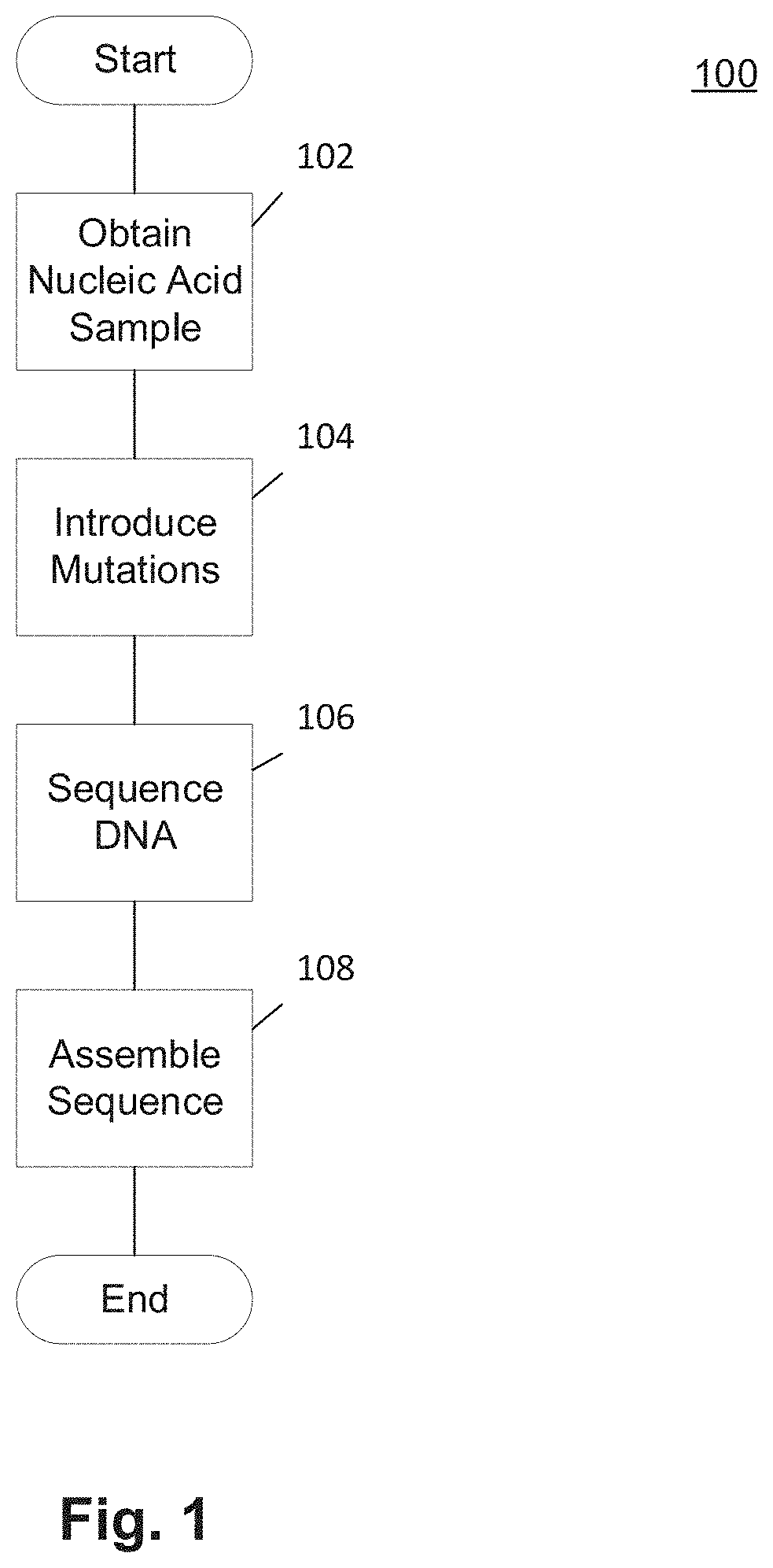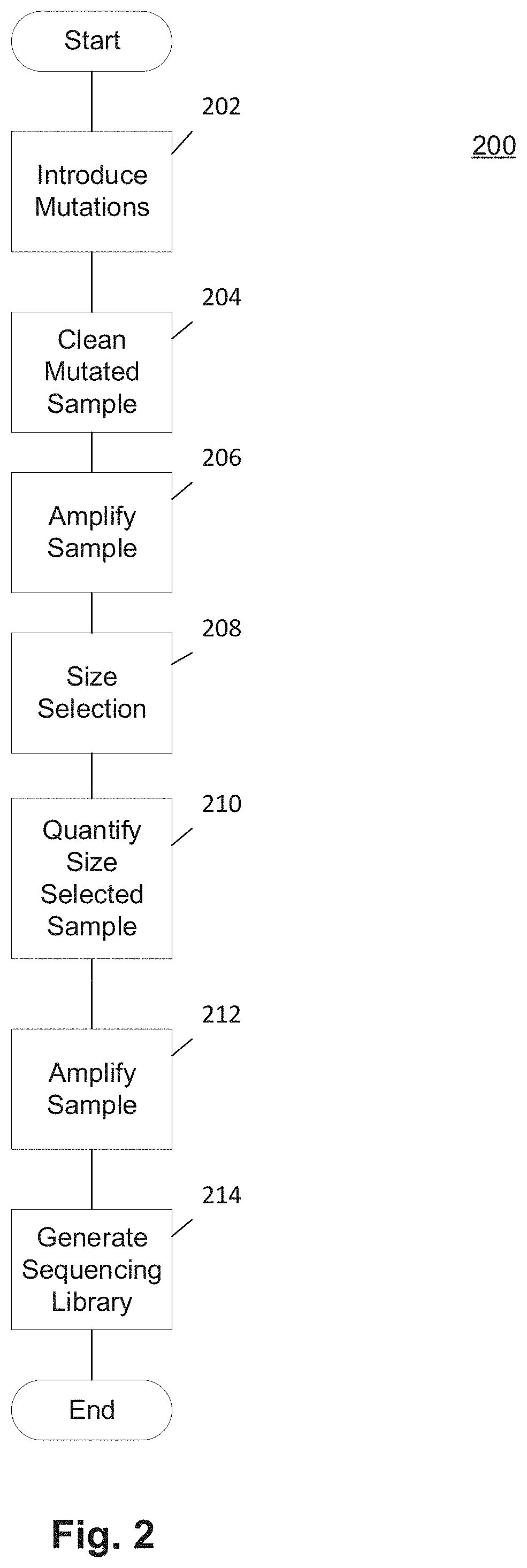Methods and Uses of Introducing Mutations into Genetic Material for Genome Assembly
a technology of genome assembly and mutation, applied in the field of nucleic acid sequencing, can solve the problems of high error rate, difficult assembly and often impossible tasks of modern sequencing platforms, and the accompanied by long reads of contemporary sequencing platforms
- Summary
- Abstract
- Description
- Claims
- Application Information
AI Technical Summary
Benefits of technology
Problems solved by technology
Method used
Image
Examples
example 1
g Mutations in Sample Nucleic Acid
[0088]Methods:
[0089]In one exemplary embodiment, genomic DNA from Arabidopsis thaliana was acquired and mutated using MDA. In this exemplary embodiment, 1 μL of 2× alkaline denaturation solution and 1 μL of genomic DNA (at a concentration of ˜5-10 ng / μL) were added to a reaction tube, mixed gently, and incubated at room temperature for 3 minutes. After this, the reaction tube was placed on ice, where 2 μL of 2× alkaline denaturation solution was added and mixed gently. After which, 16 μL of a master mix was added and mixed gently. The master mix consisted of Phi29 DNA polymerase, polymerase buffer, bovine serum albumin (BSA), random exo-resistant hexamer primers, 100 μM dNTP mix, and 200 μM dPTP. This reaction solution was incubated at 30° C. for 3 hours and 30 minutes. The reaction was stopped by increasing the temperature of the reaction to 65° C. for 3 minutes in order to denature the polymerase, followed by a 12° C. hold until further processing...
example 2
l Spectrum
[0094]Methods:
[0095]In another exemplary embodiment, the Mutational MDA was performed on A. thaliana DNA according the methods in Example 1 and the mutational spectrum was investigated for the purposes of distinguishing it from sequencing error and misalignment background noise. Additionally, three samples varied the concentration of dPTP in the reaction mix, such that a first sample used 200 μM dPTP, a second sample used 400 μM dPTP, and a third sample used 600 μM dPTP. Read alignments to the reference assembly were performed using the Bowtie 2 software.
[0096]Results:
[0097]The mutation type generated in this embodiment is predictably purine-to-purine or pyrimidine-pyrimidine. FIG. 13A illustrates the type of mutation for aligned reads from the non-mutated (left), first (middle left), second (middle right), and third (right) samples with quality scores of at least 20. As seen in FIG. 13A, the non-mutated sample shows mutations across all types of mutations, including pyrim...
example 3
g Mutated Fragments
[0101]Methods:
[0102]In one exemplary embodiment, the sequence of chromosome III of Caenorhabditis elegans was computationally mutated at a rate comparable to what can be generated by methods described above. Synthetic sequencing reads were generated based on a control (non-mutated) and a simulated mutated chromosome III sequences using the ART simulated read program. These simulated mutated sequences were selected by sampling the chromosome randomly with a window centered around 30,000 bp (with a 3,000 bp standard deviation) for a total of 0.5× coverage. The control and mutated sequencing reads were assembled using the ABySS assembler to recreate large fragments. The assembled contigs were then aligned to the chromosome III reference sequence. Finally, this process was repeated 21 times, generating mutated and non-mutated assembled contigs for a total of 10.5× coverage. These assembled contigs were subsequently assembled into a final assembly using the Canu assemb...
PUM
| Property | Measurement | Unit |
|---|---|---|
| Mass | aaaaa | aaaaa |
| Concentration | aaaaa | aaaaa |
| Size | aaaaa | aaaaa |
Abstract
Description
Claims
Application Information
 Login to View More
Login to View More - R&D
- Intellectual Property
- Life Sciences
- Materials
- Tech Scout
- Unparalleled Data Quality
- Higher Quality Content
- 60% Fewer Hallucinations
Browse by: Latest US Patents, China's latest patents, Technical Efficacy Thesaurus, Application Domain, Technology Topic, Popular Technical Reports.
© 2025 PatSnap. All rights reserved.Legal|Privacy policy|Modern Slavery Act Transparency Statement|Sitemap|About US| Contact US: help@patsnap.com



